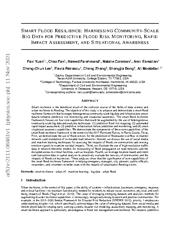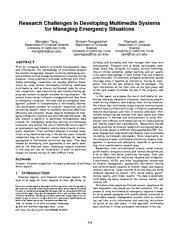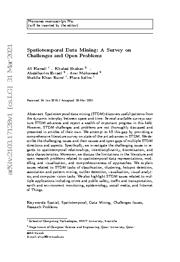A copy of this work was available on the public web and has been preserved in the Wayback Machine. The capture dates from 2019; you can also visit the original URL.
The file type is application/pdf.
Filters
Social Media Big Data Mining and Spatio-Temporal Analysis on Public Emotions for Disaster Mitigation
2019
ISPRS International Journal of Geo-Information
social media big data to assist in disaster analysis. ...
Social media contains a lot of geographic information and has been one of the more important data sources for hazard mitigation. ...
Chu, Associate Professor at Yunlin University of Science and Technology for his advice and collaborative work on the emotion classification under the framework of cooperation project. ...
doi:10.3390/ijgi8010029
fatcat:ot4aseiydnfk3onn3taik2zyd4
A Big Data Reference Architecture for Emergency Management
2020
Information
On the one hand, the availability of big data and the evolution of geographical information systems make it possible to manage and process large quantities of information that can hugely improve the decision-making ...
This paper aims to provide a reference architecture for emergency management that instantiates the NIST Big Data Reference Architecture to provide a common language and enable the comparison of solutions ...
on a spatio-temporal analysis of public emotion information [106] Operational Coordination Assessment Improved coordination between rescue teams integrating geographical, satellite, census and mobile ...
doi:10.3390/info11120569
fatcat:kxostcrulbh7lpnd3qehl7h2by
Smart Flood Resilience: Harnessing Community-Scale Big Data for Predictive Flood Risk Monitoring, Rapid Impact Assessment, and Situational Awareness
[article]
2021
arXiv
pre-print
Second, we discuss the use of social media and machine learning techniques for assessing the impacts of floods on communities and sensing emotion signals to examine societal impacts. ...
The smart flood resilience framework focuses on four core capabilities that could be augmented by the use of heterogeneous community-scale big data and analytics techniques: (1) predictive flood risk mapping ...
The authors would also like to acknowledge INRIX, Inc. and SafeGraph for providing data. ...
arXiv:2111.06461v2
fatcat:2ugdb6geivdsjp5ypzkspvldey
Research Challenges in Developing Multimedia Systems for Managing Emergency Situations
2016
Proceedings of the 2016 ACM on Multimedia Conference - MM '16
We present known issues in disaster management and then focus on emergency situations. ...
) data for situation recognition, and determining and communicating appropriate actions to people stranded during disasters. ...
To build this flood management application using EventShop, they first searched for any public data sources related to the Thai flood from both professional and social media sources. ...
doi:10.1145/2964284.2976761
dblp:conf/mm/TangPJ16
fatcat:75w6uonma5fm7fqndoz7vdzoni
Artificial Intelligence Technology and Social Problem Solving
[chapter]
2019
Communications in Computer and Information Science
by utilizing AI and ICBM (IoT, Cloud Computing, Big Data, Mobile) technologies. ...
We will also describe how all these technologies, big data, methodologies and knowledge can be combined onto an open social informatics platform. ...
In this letter, I introduce research on the informatics platform for social problem solving, specifically based on spatio-temporal data, conducted by Hanyang University and cooperating institutions. ...
doi:10.1007/978-981-13-6936-0_2
fatcat:mvrcvaxlgbcfrfydf37w7q4r5a
Opportunities and Challenges of Geospatial Analysis for Promoting Urban Livability in the Era of Big Data and Machine Learning
2020
ISPRS International Journal of Geo-Information
The main discussion revolves around the reliability of using big data from social media platforms or sensors, and how information can be extracted from massive amounts of data through novel analysis methods ...
Urban systems involve a multitude of closely intertwined components, which are more measurable than before due to new sensors, data collection, and spatio-temporal analysis methods. ...
The funders had no role in the design of the study; in the collection, analyses, or interpretation of data; in the writing of the manuscript, or in the decision to publish the results. ...
doi:10.3390/ijgi9120752
fatcat:khvtmzwomfaf3fbi3qfy7xmjru
Automated machine learning approaches for emergency response and coordination via social media in the aftermath of a disaster: A review
2021
IEEE Access
Consequently, several research articles have been published on social media utilization for disaster response. ...
Many of those recent research articles discuss automated machine learning approaches to extract disaster, indicating posts useful for coordination from various social media posts. ...
[74] show the classification of publications, the analysis of trends and the impact of published research in the context of data mining for natural disaster management. Yu et al. ...
doi:10.1109/access.2021.3074819
fatcat:2ebym34ewjcgzn7im7gaac7udy
Platial mobility: expanding place and mobility in GIS via platio-temporal representations and the mobilities paradigm
[article]
2022
arXiv
pre-print
As illustrative cases for further study using platial mobility as a framework, we explore its benefits and methodological aspects toward developing better understanding for disaster management, disaster ...
notions of mobility in GIScience, that are solely dependent on Euclidean space and time. ...
potential data sources are questionnaires, travel logs and social media data. ...
arXiv:2207.11452v1
fatcat:qx3ogrxsnrbczisq2srz2brcni
A STUDY OF VOLUNTEERED GEOGRAPHIC INFORMATION (VGI) ASSESSMENT METHODS FOR FLOOD HAZARD MAPPING: A REVIEW
2015
Jurnal Teknologi
The available methods of VGI credibility assessment mainly focus on meta data analysis, VGI spatial pattern analysis and comparison of VGI data with reference data. ...
Since this information is created by volunteers, its reliability and credibility issues bring restriction on use of them as main source of information. ...
Acknowledgement The authors would like to thank and acknowledge the Universiti Teknologi Malaysia (UTM) and Ministry of Education of Malaysia (MOE) for their financial supports on the research grant Vot ...
doi:10.11113/jt.v75.5281
fatcat:3nnodqnbg5hb5kreivm7fmmdy4
Spatiotemporal Data Mining: A Survey on Challenges and Open Problems
[article]
2021
arXiv
pre-print
We also highlight STDM issues related to multiple applications including crime and public safety, traffic and transportation, earth and environment monitoring, epidemiology, social media, and Internet ...
Spatiotemporal data mining (STDM) discovers useful patterns from the dynamic interplay between space and time. ...
Social Media Analysis Data provided by social media is affected by the growth of sensor technologies that generate big spatiotemporal data, such as check-in records, user reviews, and geo-temporal tagged ...
arXiv:2103.17128v1
fatcat:ci5pt5bytndr5inolznjsaizpi
A large-scale spatio-temporal data analytics system for wildfire risk management
2017
Proceedings of the Fourth International ACM Workshop on Managing and Mining Enriched Geo-Spatial Data - GeoRich '17
In this paper, we describe a large-scale data-driven system for personalized risk mitigation, fire response's resource optimization and dynamic evacuation planning. ...
However, this requires accessing and processing large amounts of spatial and temporal data from a number of sources in near real-time, while ensuring the immediate availability of risk measurement results ...
IoT devices can provide a variety of personalized data about the house and environment, as well as social media can be used as a rich data source. ...
doi:10.1145/3080546.3080549
dblp:conf/sigmod/WangVSRRP17
fatcat:guty2c6cabbfxg46jbll23ltr4
Natural Disasters Detection in Social Media and Satellite imagery: a survey
[article]
2019
arXiv
pre-print
In this paper, we survey the existing literature on disaster detection and analysis of the retrieved information from social media and satellites. ...
of disaster-related visual content from social media; and (iii) disaster detection in satellite imagery. ...
analyze social media data for disasters. ...
arXiv:1901.04277v1
fatcat:5zidbp3owbe6ld33pt4j3aijtq
Deep Learning for Earthquake Disaster Assessment: Objects, Data, Models, Stages, Challenges, and Opportunities
2023
Remote Sensing
Next, this study analyses the application distribution, advantages, and disadvantages of the three types of data (remote sensing data, seismic data, and social media data) mainly involved in these studies ...
Earthquake Disaster Assessment (EDA) plays a critical role in earthquake disaster prevention, evacuation, and rescue efforts. ...
Social media data are the least frequently used data type, primarily for disaster extraction, post-disaster sentiment analysis, and other related tasks. ...
doi:10.3390/rs15164098
fatcat:34fvit3r2rhgfelhtcj3gu7qky
Machine Learning Information Fusion in Earth Observation: A Comprehensive Review of Methods, Applications and Data Sources
2020
Information Fusion
Earth observation is well equipped with remote sensing systems, mounted on satellites and airborne platforms, but it also involves in-situ observations, numerical models and social media data streams, ...
This paper reviews the most important information fusion data-driven algorithms based on Machine Learning (ML) techniques for problems in Earth observation. ...
Figure 7 : 7 Illustrations of Social Media Statistics on the example of Twitter public stream data. ...
doi:10.1016/j.inffus.2020.07.004
fatcat:m57jbkxnhjfqvgt5ol6iei35ta
The FuturIcT Knowledge Accelerator: Unleashing the Power of Information for a Sustainable Future
[article]
2010
arXiv
pre-print
The need of a socio-economic knowledge collider was first pointed out in the OECD Global Science Forum on Applications of Complexity Science for Public Policy in Erice from October 5 to 7, 2008. ...
to study the way our living planet works in a social dimension. ...
to validate models, and further data required for substantial simulations are becoming available through multi-source massive social data mining (e.g. reality mining with mobile phones, sensors, and on ...
arXiv:1004.4969v2
fatcat:gp6ukpvmqjcrnh2k7e7muzf6yy
« Previous
Showing results 1 — 15 out of 320 results















